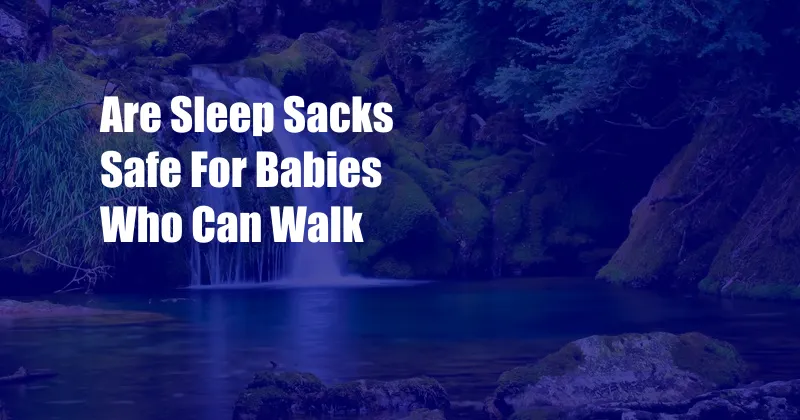
Are Sleep Sacks Safe for Babies Who Can Walk?
As a parent, ensuring your baby’s safety and comfort during sleep is paramount. You may wonder if a sleep sack continues to be a safe option once your baby starts walking. In this comprehensive article, we will delve into the safety aspects of sleep sacks for babies who can walk, providing you with the necessary information to make informed decisions.
Before exploring the safety concerns, let’s understand what sleep sacks are and their benefits for infants. Sleep sacks, also known as wearable blankets, are designed to keep babies warm and comfortable while sleeping. They come in various sizes and styles, providing a snug and secure environment for infants.
Sleep Sacks for Walking Babies: Safety Considerations
The primary concern with sleep sacks for babies who can walk is the potential for tripping or getting tangled. When a baby starts walking, they become more mobile and may accidentally step on or become entangled in the sleep sack, leading to falls or accidents.
Another consideration is the risk of overheating. Sleep sacks can retain heat, and while this is beneficial for younger babies, it may pose a problem for babies who are active and generate their body heat. Overheating can lead to discomfort, sweating, and restlessness, disrupting a baby’s sleep.
Choosing the Right Sleep Sack for Walking Babies
To mitigate the safety concerns, it is essential to choose the appropriate sleep sack for a baby who can walk. Here are some factors to consider:
- Size: Opt for a sleep sack that fits snugly but allows your baby to move freely. It should not be too loose or too tight.
- Length: As the sleeping bag for babies who can walk, it should be long enough to cover their legs without dragging on the ground.
- Style: Choose a sleep sack with feet, as this will allow your baby to move around safely.
- Material: Select a sleep sack made from breathable fabric, such as cotton or bamboo, to prevent overheating.
- Tog Rating: The tog rating indicates the warmth of the sleep sack. Choose a lower tog rating (0.5-1.5) for a baby who can walk.
Tips and Expert Advice
In addition to choosing the right sleep sack, there are a few additional tips and expert advice to ensure your baby’s safety:
- Monitor your baby regularly: Keep an eye on your baby while they sleep in a sleep sack to ensure they are not getting tangled or overheating.
- Use a sleep sack with feet holes: This allows your baby to move around freely and reduces the risk of tripping.
- Avoid using sleep sacks with blankets: This can increase the risk of overheating and entanglement.
- Do not use sleep sacks if your baby has mobility issues: If your baby has difficulties walking or moving, consult with a healthcare professional before using a sleep sack.
FAQ on Sleep Sacks for Walking Babies
Q: What are sleep sacks?
A: Sleep sacks are wearable blankets designed to keep babies warm and comfortable during sleep.
Q: Are sleep sacks safe for babies who can walk?
A: Yes, sleep sacks can be safe for walking babies if they are chosen and used appropriately.
Q: What are the risks of using sleep sacks for walking babies?
A: The risks include tripping, entanglement, and overheating.
Q: How to choose a safe sleep sack for a walking baby?
A: Choose a sleep sack with feet, made from breathable fabric, and the right size and tog rating.
Q: What additional safety tips should I follow?
A: Monitor your baby regularly, use a sleep sack with feet holes, avoid using sleep sacks with blankets, and consult with a healthcare professional if your baby has mobility issues.
Conclusion
To answer the question, yes, sleep sacks can be safe for babies who can walk provided they are used appropriately. By choosing the right sleep sack and following the safety tips outlined in this article, you can create a safe and comfortable sleeping environment for your active baby.
Remember, the safety and well-being of your child should always be a priority. If you have any concerns about using a sleep sack with your baby who can walk, consult with your healthcare provider for personalized advice.